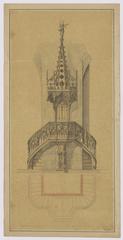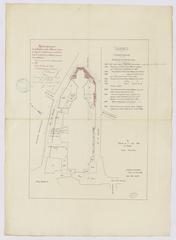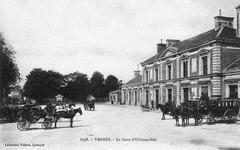
Vannes Cathedral: Complete Guide – Visiting Hours, Tickets, History & Architectural Highlights
Date: 14/06/2025
Introduction
Vannes Cathedral, officially Cathédrale Saint-Pierre de Vannes, is a majestic symbol of Brittany’s religious, cultural, and architectural heritage. Located in the heart of Vannes, France, this cathedral offers visitors a journey through over 1,500 years of history—from its early Christian origins and Romanesque foundations to its Gothic grandeur and Renaissance artistry. Today, Vannes Cathedral is not only an active place of worship and community gathering but also an architectural and historical marvel open to all. This guide provides essential information on visiting hours, tickets, accessibility, guided tours, and the cathedral’s historical and cultural significance, as well as tips for exploring nearby attractions (cathedrale-vannes.fr; bretagne-tourisme.com; christianedirectory.com).
Historical Overview
Early Origins and Founding (5th–10th Centuries)
The site of Vannes Cathedral traces back to the late 5th century, when Saint Patern was consecrated as the first bishop of Vannes. The original building, likely a simple wooden structure, served the early Christian community but was destroyed during the Norman invasions in 919. This devastation marked the beginning of successive reconstructions, each leaving its mark on the cathedral’s evolving form (cathedrale-vannes.fr).
Romanesque and Medieval Expansion (11th–13th Centuries)
In the 11th century, Bishop Judicaël and Duke Geoffroy I spearheaded the construction of a more substantial Romanesque cathedral, characterized by granite walls, rounded arches, and a robust bell tower. The building was further expanded in the late 12th century, with architectural influences from the Maine region. The three-level elevation of arcades, arcatures, and windows blends Romanesque and early Gothic features (france-voyage.com; bretagne-tourisme.com).
Gothic and Renaissance Transformations (15th–16th Centuries)
A major Gothic reconstruction began in 1454, led by Bishop Yves de Pontsal, to accommodate pilgrims and the growing population. The nave, transepts, and grand portal were rebuilt in Gothic style. The Renaissance Rotonde du Saint-Sacrement, a unique circular chapel with Italianate details, was added in 1537 and is notable for its Corinthian pilasters and domed roof (cathedrale-vannes.fr).
Baroque, Neoclassical, and Revolutionary Periods (17th–19th Centuries)
The cathedral’s interior was enriched with Baroque altarpieces and a new marble high altar in the 18th century. The French Revolution saw the church repurposed for secular use, but it was returned to religious service in 1796, followed by extensive 19th-century restorations influenced by Viollet-le-Duc’s neo-Gothic vision. The current façade and many stained glass windows date from this period (bretagne-tourisme.com).
Modern Preservation and Recent Works
Vannes Cathedral was designated a minor basilica in 1870 and remains an active religious center. Restoration efforts in the 21st century focus on structural integrity, stonework, and the conservation of artistic treasures. Since January 2025, major restoration has temporarily relocated liturgical functions but the cathedral remains open for visits (cathedrale-vannes.fr).
Architectural Synthesis and Distinctive Features
- Romanesque Bell Tower: Dating from the 11th century, the bell tower anchors the cathedral’s western end with its heavy stonework and rounded arches (christianedirectory.com).
- Gothic Nave and Transepts: The soaring nave, ribbed vaults, and pointed arches epitomize Gothic style. The nave is lined with ten side chapels, each with its own artistic character.
- Renaissance Rotonde: The circular Rotonde du Saint-Sacrement is unique in France for its centralized plan and Italianate ornamentation.
- Baroque and Neoclassical Elements: The high altar, choir stalls, and side altars reflect Baroque and neoclassical influences introduced in the 17th and 18th centuries.
- Stained Glass Windows: The cathedral boasts a remarkable collection of stained glass, some dating back to the 15th century, with vibrant biblical scenes and local saints (touristsecrets.com).
- Pipe Organ: The 18th-century organ, with its historic casework, is still used for concerts and services (triplyzer.com).
Religious and Cultural Significance
Vannes Cathedral is the seat of the Bishop of Vannes and a spiritual heart for the region. It hosts daily Mass, sacraments, and major diocesan celebrations. The tomb of Saint Vincent Ferrer, a revered 15th-century Dominican preacher, attracts pilgrims, especially on his feast day, April 5th (choosewhere.com). The cathedral also embodies Breton religious traditions, blending Catholic liturgy with local language and customs (explorecity.life).
Culturally, the cathedral anchors Vannes’ historic center and plays a vital role in local festivals, concerts, and educational outreach. It is a focal point for civic life and heritage tourism (thegoodlifefrance.com).
Visitor Information
Visiting Hours
- Regular Hours: Daily, 10:30 AM – 6:00 PM (subject to change during restoration and special events; check official website)
- Liturgical Services: Temporarily relocated during the ongoing restoration (2025–2027)
Tickets & Entry
- Admission: Free of charge for general entry. Donations are appreciated to support restoration.
- Guided Tours: Available in French and occasionally English; advance booking recommended during peak seasons.
Accessibility
- Wheelchair Access: Main entrance and nave are accessible; some chapels and the bell tower may have stairs or uneven flooring.
- Facilities: Accessible restrooms and assistance available upon request.
Location & Getting There
- Address: Place Saint-Pierre, 56000 Vannes, France
- Transport: 15-minute walk from Vannes train station; public parking nearby (spaces limited).
Visitor Tips
- Photography: Non-flash photography is allowed except during services.
- Dress Code: Modest attire is recommended.
- Quiet Reflection: Maintain a respectful demeanor, especially during liturgical events.
- Best Times to Visit: Early mornings or late afternoons are less crowded (solosophie.com).
Guided Tours & Audio Guides
- Tours: Guided tours and audio guides provide in-depth historical context and are available through the tourist office or cathedral website.
- Group Visits: Educational and group tours may be arranged with advance notice.
What to See Around Vannes Cathedral
- Medieval Ramparts: Historic city walls with towers and gardens.
- Place Henri IV: Picturesque square with timber-framed houses.
- Château de l’Hermine: Former ducal residence, now hosting exhibitions.
- Port de Vannes: Lively harbor area with cafés and markets.
Special Events & Festivals
- Fêtes Historiques de Vannes (July): Medieval reenactments with processions starting or ending at the cathedral.
- Concerts: Organ recitals and classical music performances.
- Religious Festivals: Christmas, Easter, and Saint Vincent Ferrer’s feast day are celebrated with special liturgies and decorations (choosewhere.com).
Frequently Asked Questions (FAQ)
Q: What are the current visiting hours?
A: Daily from 10:30 AM to 6:00 PM; hours may change during restoration or holidays.
Q: Is there an admission fee?
A: Entry is free; donations are welcome.
Q: Are guided tours available?
A: Yes, especially during tourist season; book in advance.
Q: Is the cathedral accessible for wheelchairs?
A: The main areas are accessible; some older sections and the bell tower may not be.
Q: Can I take photographs?
A: Yes, non-flash photos are allowed except during services.
Visuals and Interactive Resources
Plan Your Visit: Insider Tips
- Combine Visits: Explore the cathedral along with Vannes’ medieval ramparts, Place Henri IV, and local museums.
- Check Events: Look for special concerts or festivals coinciding with your visit.
- Use Digital Resources: Download the Audiala app for audio guides and insider tips.
Summary & Final Recommendations
Vannes Cathedral stands as a testament to Brittany’s spiritual, artistic, and communal life. Its architectural layers—from Romanesque bell tower to Gothic nave and Renaissance Rotonde—offer a rich tapestry of history and culture. As both a living church and a heritage landmark, it welcomes visitors year-round for reflection, discovery, and inspiration. For the latest updates on opening hours, restoration progress, and events, consult the official website or the local tourist office. Enhance your visit by exploring nearby attractions and using digital guides for an enriched experience (cathedrale-vannes.fr; bretagne-tourisme.com; choosewhere.com).
Sources
- Vannes Cathedral Official Website
- Bretagne Tourisme – Vannes Cathedral
- Christiane Directory – St. Peter’s Cathedral Basilica Vannes
- Travel France Tips – Vannes Saint-Pierre Cathedral
- Choose Where – Vannes Visitor Guide
- Tourist Secrets – Vannes
- France Voyage – Vannes Cathedral
- Explore City Life – Vannes
- CPTLyne – Things to Do in Vannes
- Spotting History – Vannes Cathedral
- Triplyzer – Vannes
- The Crazy Tourist – Vannes
- Visit Places France – Vannes Cathedral
- Solo Sophie – Vannes
- Revigorate – Things to Do in Vannes
- Educba – Tourist Attractions in Vannes
- The Good Life France – What to Do in Vannes
- Wikipedia – Vannes Cathedral
- Britannica – Vannes




